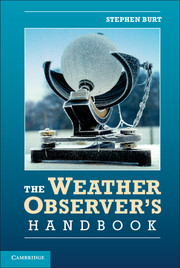Book contents
- Frontmatter
- Contents
- Acknowledgements
- Abbreviations, footnotes and references
- Part One The basics
- Part Two Measuring the weather
- 5 Measuring the temperature of the air
- 6 Measuring precipitation
- 7 Measuring atmospheric pressure
- 8 Measuring humidity
- 9 Measuring wind speed and direction
- 10 Measuring grass and earth temperatures
- 11 Measuring sunshine and solar radiation
- 12 Observing hours and time standards
- 13 Dataloggers and AWS software
- 14 Non-instrumental weather observing
- 15 Calibration
- 16 Metadata – what is it, and why is it important?
- Part Three Making the most of your observations
- Appendix 1 Metrology and meteorology: The basics of instrument theory
- Appendix 2 Useful functions
- Appendix 3 Unit conversions
- Appendix 4 Useful sources
- Index
- References
7 - Measuring atmospheric pressure
Published online by Cambridge University Press: 05 July 2012
- Frontmatter
- Contents
- Acknowledgements
- Abbreviations, footnotes and references
- Part One The basics
- Part Two Measuring the weather
- 5 Measuring the temperature of the air
- 6 Measuring precipitation
- 7 Measuring atmospheric pressure
- 8 Measuring humidity
- 9 Measuring wind speed and direction
- 10 Measuring grass and earth temperatures
- 11 Measuring sunshine and solar radiation
- 12 Observing hours and time standards
- 13 Dataloggers and AWS software
- 14 Non-instrumental weather observing
- 15 Calibration
- 16 Metadata – what is it, and why is it important?
- Part Three Making the most of your observations
- Appendix 1 Metrology and meteorology: The basics of instrument theory
- Appendix 2 Useful functions
- Appendix 3 Unit conversions
- Appendix 4 Useful sources
- Index
- References
Summary
This chapter covers the measurement of atmospheric or barometric pressure (often abbreviated to ‘air pressure’ or simply ‘pressure’), and its importance.
Air pressure is one of the most important of all meteorological elements. Fortunately, it is also the easiest of all to measure, particularly with modern sensors, and even basic AWSs or household aneroid barometers can provide reasonably accurate readings. It is also the only instrumental weather element that can be observed indoors, making a barometer or barograph – analogue or digital – an ideal instrument for weather watchers living in apartments, or those who for whatever reason are unable to site weather instruments outside. It is important, however, to ensure that pressure sensors are correctly exposed to ensure consistent and reliable readings: WMO recommendations on exposure and instrument accuracy [1] are included.
Great accuracy is not required for casual day-to-day observations, as very often the trend of the barometer in temperate latitudes, whether it is rising or falling, and how rapidly, provides the best single-instrument guide to the weather to be expected over the next 12–24 hours.
Where accurate air pressure records are required, the observed barometer reading needs to be adjusted to a standard level, usually mean sea level (MSL), because of the rapid decrease in air pressure with altitude. Uncorrected readings simply reflect the height of the instrument above sea level, rather than the true variations of pressure shown by isobars (lines of equal pressure) on a weather map. This chapter explains how to correct or ‘set’ a barometer to mean sea level. Accurate records also require the calibration of the pressure sensor to be checked regularly to avoid calibration drift, which can become substantial if not corrected. Methods for doing this are explained, with examples.
- Type
- Chapter
- Information
- The Weather Observer's Handbook , pp. 167 - 182Publisher: Cambridge University PressPrint publication year: 2012



